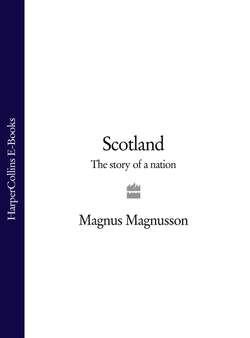Читать книгу Scotland: The Story of a Nation - Magnus Magnusson - Страница 26
The coming of Christianity
ОглавлениеBefore the Romans officially declared an end to their occupation of Scotland, in 410, the south-west of Scotland may already have been Christianised; early in the fourth century the Emperor Constantine had declared Christianity to be the official religion of the Roman Empire, and this may have led to the establishment of some kind of ‘sub-Roman Church’ in Pictland.
The Venerable Bede wrote that, after Constantine made Christianity official, ‘faithful Christians who during the time of danger had taken refuge in woods, deserted places and hidden caves, came into the open and rebuilt the ruined churches. Shrines of the martyrs were founded and completed and openly displayed everywhere as tokens of victory. The festivals of the Church were observed, and its rites performed reverently and sincerely.’
The one name which emerges from the scanty sources about south-west Scotland during this period is that of St Ninian. Ninian (Nynia) is the first Christian missionary in Scotland’s history who is known to us by name. Bede called him ‘a most reverend and holy man of British race’, and recorded a tradition that he had been trained in Rome and that his see was at St Martin’s Church at Candida Casa (the ‘White House’), identified as Whithorn in Galloway. He was, apparently, the son of a converted British chieftain, who began his mission in the south-west late in the fifth century as the bishop of a Romanised community which had been Christian for some time. By the seventh century Ninian had become a cult saint, and many churches were dedicated to him in different parts of Scotland in the ensuing centuries.
In the west of Scotland, St Kentigern, or Mungo,1 founded a church beside the Molindinar Burn; it was in a ‘green hollow’ (glascu), which gave the city of Glasgow its name. By 600, Kentigern/Mungo was established as the first bishop of the kingdom of Strathclyde centred on Dumbarton; his shrine lies in the crypt of Glasgow Cathedral.
The man most closely associated with the spread of Christianity in the sixth century, however, is Columba (Colum Cille, ‘Dove of the Church’, c.521–97). He was a scion of the Uí Néill, the most powerful royal family in Ireland at the time. Columba was a vigorous and hot-blooded warrior-monk who was banished after a particularly bloody battle and, as a penance, chose to lead a mission to the Scoti of Dalriada. In 563 he set sail in a coracle with twelve companions to do God’s work. After some years on an island which Columba called Hinba (perhaps Jura), the king of Dalriada gave him the island of Iona, off the west coast of Mull, probably in the early 570s. Here he founded a large monastic community which was to become the spiritual powerhouse of Christianity in northern Britain. It also became a renowned centre of learning and artistic excellence, and owned an extensive library of books: many claim that the magnificently illustrated Book of Kells, now in the library of Trinity College, Dublin, was produced in a scriptorium on Iona. Columba’s biographer, Adomnán, wrote that he was engaged in making a new manuscript of a psalter on the day of his death.
The major impact of the Church was the introduction of writing, and the close and mutually beneficial relations between Church and state. The Church was both client and patron of the monarchy. Columba himself ordained one of the kings of Dalriada (Áedán mac Gabhráin) on Iona in 574. Another graphic impact was on Pictish art: following the advent of Christianity the Pictish symbol-stones were shaped into slabs with a dominant cross carved on one face, and Biblical figures like David were introduced to symbolise kingship, alongside the characteristic ornamentation of spirals, snakes, dragons, birds and fish.
Although both the Picti and the Scoti were ethnic Celts, the Picts were not the same kind of Celts as those incomers who came from Ireland around 500 to found the kingdom of Dalriada. The language the Picts spoke was ‘British’ or ‘Brittonic’ Celtic, akin to Welsh, Cornish and Breton (scholars call it ‘P-Celtic’), whereas modern Irish and Scottish Gaelic descend from Goidelic Gaelic (which is classified as ‘Q-Celtic’). The eventual assimilation of the Picts into the Gaelic culture of the Scots was made much easier through the influence of Christianity. Having been converted by Columban missionaries, the Picts looked to Iona as the head of their Church. Differences between Picts and Gaels began to be reduced, through intermarriage and the exchange of church personnel. So it is reasonable to assume that it was the rise of the Gaelic Church in Pictland which laid the foundations for the ultimate unification of the Picts and Scots as a new kingdom.
But before that could come about, there was another threat to be faced, in the shape of an enemy who would serve to bring the Picts and the Scots even closer together – the vikings.
